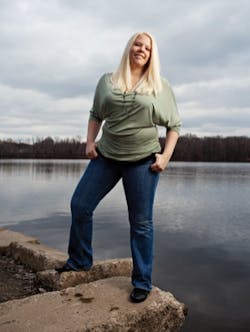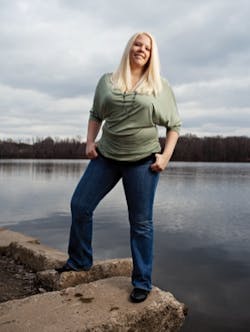Carolyn: From grumpy to happy
Periodontal trays rescue awkward patient relationship
Kim Stevens, RDH, BS, MBA
The usual protocol after the doctor has been to a continuing education course over a weekend is an implementation of what he learned while at the course. He says, “Good morning!” in the hallway and then asks, “Have you heard about the new tray method to treat periodontal disease, and what do you think about it?” Your face switches from the pleasant good morning face to “the look.” You reply, “Yah, right.”
“That’s what I thought you would say,” he replies, and the subject is dropped.
Relationships between doctors and hygienists either reflect an open partnership or simply an employer/employee relationship where “what do you think?” conversations are rare. Either way, implementing new treatments and procedures still needs to happen with both fully participating for a successful outcome.
After attending a weekend course, I greeted the doctor coming down the hallway, only without the good morning salutation because I was so excited! I learned all about a tray method for treating periodontal disease at the seminar. While I still wanted to see the results to be completely persuaded, I eagerly wanted to try it out.
I told him it was necessary for him to get certified before we could start our patients on this new treatment. He and I were both certified, and we were off and running. We started with the S/RP patients, some periodontal maintenance patients, and certain patients with health issues, especially heart disease and diabetic patients.
This is where the story about Carolyn begins. I first saw her when I started with the practice in 1995, but only once. I was the first hygienist in that practice because of its rural location, and she wanted to see only the doctor for her cleanings and exams. So for the next decade she did not see me again.
She was 67 years old and had periodontal disease. After letting her know her gum condition and not liking what she heard, she made sure it was not addressed again. I was surprised at her reaction because she had shared having had a huge complex about her teeth and breath. She said a boy she had a crush on in high school told a friend of hers that he would not date her because her breath smelled so bad. She was cold, short with me, and just generally not a happy person.
Over ten years of having only a topical scaling and polishing every six months, the periodontal disease had progressed, and she had to be confronted with the conversation she was sure would never be brought up again. The doctor recommended that she see his hygienist for a deep cleaning. She immediately refused, as he thought she would, but he was ready with asking her if she wanted to lose her teeth. She said she didn’t want that and would give his hygienist another try.
Nobody warned me ahead of time about who Carolyn was, or her feelings toward treatment by dental hygienists until 30 seconds before I saw her. The office has a long shotgun-type hallway, and my room is the last one on the left. It was a long, dreaded walk for both of us. I realize I am painting a sorrowful picture of this appointment. But it really was dreaded, and it’s important to know this part of her history.
I reviewed her health history, and she said everything was fine. I also reviewed why she was seeing me and played a short patient education video about periodontal disease and what the hidden pocket numbers meant. I began pocket charting with a digital system called the Florida Probe. It says the measurement out loud so the patient has a general idea where they stand when you are finished. The measurements were generalized 6-10 mm and by the second or third number she heard, she asked if I would turn off the sound. I told her it was important for her to hear so she would have an idea of where things stood with her teeth and gums.
The deepest pocket was 10mm and was on the mesial of No. 31. It had drifted mesially because No. 30 had been missing for many years. The tooth was lying forward, and the prognosis was not good. The upper arch was generalized 6-8 mm with bleeding and pus everywhere. The lower arch was worse, with several 9 mm pockets.
When I was finished, I sat her back up, and we reviewed what we both heard. She knew the situation was getting bad and at least acknowledged it. I told her I needed to do a deep cleaning, avoiding the S/RP dental terms that she resisted. However, she adamantly refused, and it was clear she was not budging.
I tried not to reveal my frustration, suggesting that the only thing left that I could do for her was take impressions and make her the Perio Protect trays. But I pointed out that she would probably lose her teeth, especially since she wouldn’t let me take any of the deep tartar off. After all, I am thinking like a hygienist. You can’t leave that stuff on there and get any good results. I also told her she would have to wear them six or seven times a day for 10-15 minutes with some gel and other medicine in them.
All she said was, “I can do that.” I took impressions of both arches and delivered the trays along with gel and doxycycline syrup about 10 days later, instructing her on how to wear them. It was a short-and-to-the-point appointment. She was scheduled for a follow-up appointment two weeks later to see how she was doing with them. She cancelled that appointment, though, along with two others.
Two months later, she finally showed up. I wasn’t sure what to think. Did she wear the trays? Was she there to give them back? I experienced anxiety. I got to the reception area door, and opened it to call her name. Before I actually called her name out, I looked at her, and she was smiling. Her entire countenance was different.
I am sure the shock on my face could not be hidden. Carolyn just kept smiling, and we started that long walk down the hall. I usually have some sort of conversational greeting, but I was speechless. We got to my room, and I laid her back. She was still smiling, and I was still speechless. I will never forget it. I looked in her mouth, and I couldn’t believe what I saw.
Her gums looked pink, not purplish red from disease, and the clinically visible calculus seen before using the trays was no longer there. I backed up from her and said her name, “Carolyn.”
She said, “I know!”
What she said next was amazing. She told me about that, after the last appointment, she started making appointments and seeing other doctors because she was certain that she was dying of cancer or some disease. She had no energy to do anything. She was just sitting in her chair at home doing nothing because she physically couldn’t get up.
But by the end of the first week of wearing her trays, her mouth felt completely different, and that physically she hasn’t felt that good and full of energy since she was in her thirties. I was still in shock at this point and really not sure what to think. She was a different patient. Then she really set me back when I told her I wanted to see her in 30 days after her Vibramycin syrup was finished to clean her teeth and take her measurements again. She said OK!
She came back for that appointment, and I had to really hunt to find any calculus, and she bled only in one spot. Her measurements were so much better. She had just a few fours, mostly twos and threes, and that ten was now a five and not bleeding at all. Her tissue was coral pink and her gums were tight.
The weekend course I attended suggested, that when patients comply, this outcome can happen. But I truly would never have believed this outcome was even remotely possible if I hadn’t witnessed it with my own eyes.
This method is working for all of my patients who comply with the instructions. Most of them do comply and are very pleased with the shorter, easier appointments they experience as a result of using the trays, and many of them express that they just plain feel better. Since a chronic infection is not draining their systems anymore, you can understand why. The practice has been prescribing the trays for almost six years now, with really great results. The increase in hygiene production has been significant as well.
I had to leave the practice for about three years fairly soon after the tray system was implemented. I recently returned and Carolyn came in for her appointment. She was still a compliant, happy, healthier patient. Number 31 had been extracted and the area was restored with a bridge. I told her I had been sharing her story with many people and she just beamed.
The doctor and I wear the trays as well. Not because we have gum problems, but because if it helps patients with gum problems like that, and the suspected systemic links are known, it surely can’t hurt. These trays are FDA cleared medical devices and are a minimally invasive procedure. They are a tremendous benefit for oral and systemic health. The only known side effect is that it whitens your teeth. I cleaned the doctor’s teeth recently and he used to build up a ton of calculus. He had very little this time and what he did have was very easy to remove. His teeth were also much whiter. That is a result of Perio Protect twice a day for 10 minutes.
I have been practicing for more than three decades, and this experience caused a huge paradigm shift for me. Before I witnessed this with Carolyn, I would truly have not believed this outcome was possible without S/RP first, period. If you have not heard about Perio Protect, or you have and reacted as I did initially, I hope this story helps to change your mind. Take the seminar, get certified, and start implementing this in your practice. There is an abundance of science available, and we all want as much science as we can get, but the real convincing that changed this doubting Thomas’ mind and attitude was the results I have seen.
For more information and directions for certification, go to www.perioprotect.com.
Kim Stevens, RDH, has been practicing dental hygiene for more than 30 years. She holds two bachelor’s degrees and an MBA, and is a published author and a national speaker. In addition to being a certified consultant for HygieneFusion, Kim holds certifications in orofacial myology, advanced periodontal treatments, and cancer screenings. She also has certifications with both the Nd:YAG and diode lasers and has been a speaker and instructor for both. She can be contacted at [email protected]

